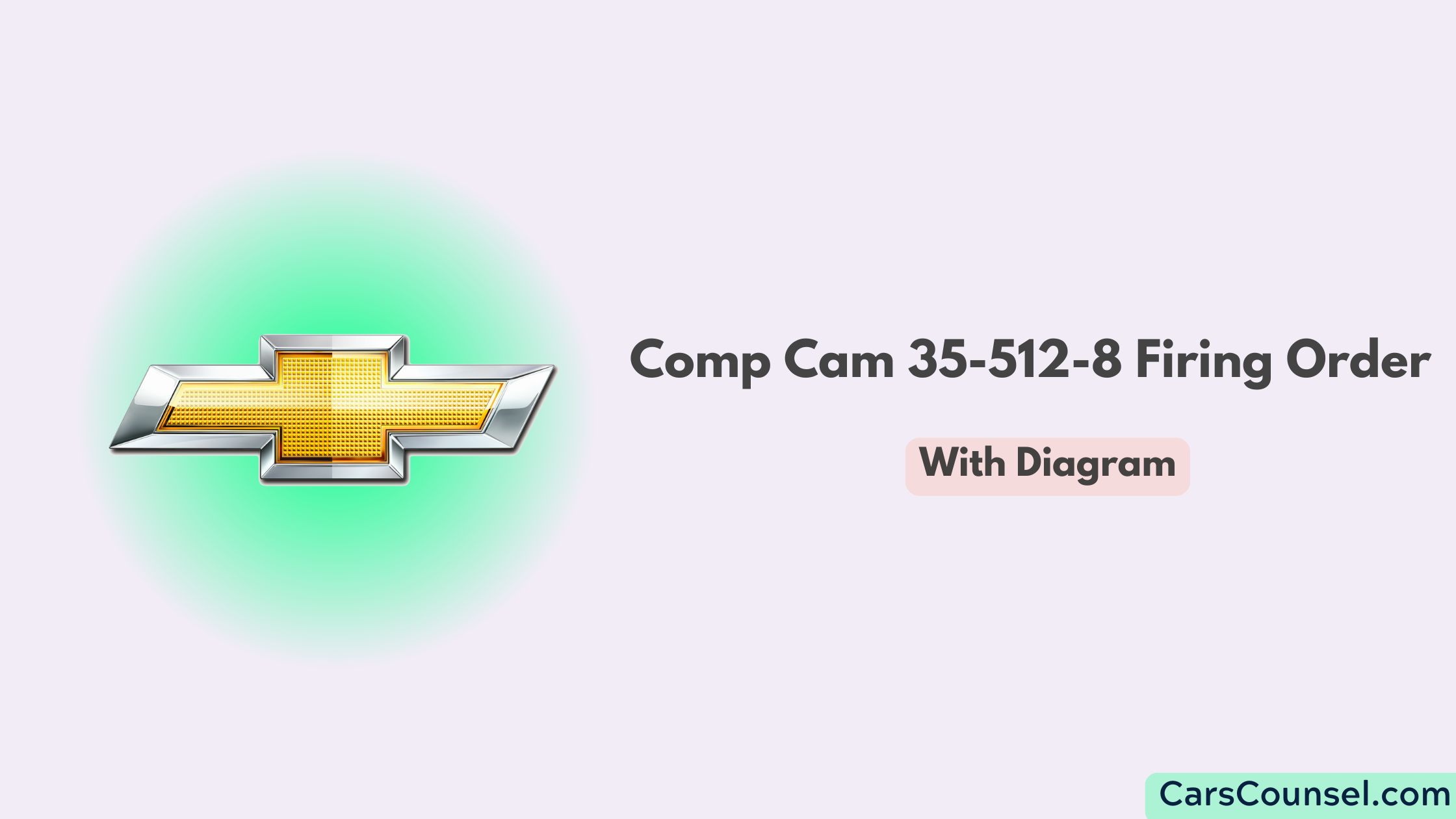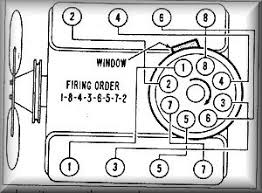The Comp Cams 35-512-8 camshaft is a popular choice among automotive enthusiasts seeking enhanced performance from their small-block engines. Designed for aggressive street and track use, this camshaft is tailored for Chevrolet’s small-block V8 engines.
A critical element of the engine’s smooth operation when using the Comp Cams 35-512-8 is its firing order—the sequence in which the engine’s cylinders fire.
In this article, we’ll explore the firing order for engines utilizing the Comp Cams 35-512-8 camshaft, discuss its importance, and provide practical insights for tuning and maintenance.
Understanding the firing order is crucial for optimal performance, whether you’re upgrading your engine or troubleshooting ignition issues.

Quick Navigation
What Is a Firing Order?
The firing order is the sequence in which the engine’s spark plugs ignite the air-fuel mixture in each cylinder. These controlled ignitions produce the power that drives the crankshaft and powers the vehicle. In a V8 engine, the firing order is specifically designed to balance engine performance and reduce mechanical vibrations.
Why Is the Firing Order Important?
- Smooth Operation: Ensures balanced combustion and minimizes engine vibrations.
- Performance: Provides consistent power delivery for smooth acceleration and reliable operation.
- Efficiency: Promotes complete combustion, improving fuel economy and reducing emissions.
- Durability: Distributes stress evenly across the crankshaft and other internal components, extending engine life.
Overview of the Comp Cams 35-512-8 Camshaft
The Comp Cams 35-512-8 is a hydraulic roller camshaft specifically designed for Chevrolet small-block engines, including the 350 and 383 stroker variants. It is part of the Extreme Energy™ series, known for optimizing horsepower and torque while maintaining street usability.
Key Features of the 35-512-8 Camshaft
- High Lift and Duration: Maximizes airflow into the engine for increased power output.
- Hydraulic Roller Design: Reduces friction and wear, improving efficiency and longevity.
- RPM Range: Operates effectively in the 2,200–6,500 RPM range, making it suitable for high-performance applications.
The Firing Order for Small-Block Chevrolet Engines
The firing order for a Chevrolet small-block V8 engine, including those equipped with the Comp Cams 35-512-8 camshaft, is:
1-8-4-3-6-5-7-2

How the Firing Order Works
- Cylinder 1 Fires First: Located at the front of the engine on the driver’s side.
- Cylinder 8 Fires Second: Positioned at the rear of the engine on the passenger’s side.
- Cylinder 4 Fires Third: Found on the passenger’s side, second from the front.
- Cylinder 3 Fires Fourth: Located on the driver’s side, second from the front.
- Cylinder 6 Fires Fifth: Positioned on the passenger’s side, third from the front.
- Cylinder 5 Fires Sixth: Found on the driver’s side, third from the front.
- Cylinder 7 Fires Seventh: Located on the driver’s side, rear position.
- Cylinder 2 Fires Last: Positioned on the passenger’s side, front position.
This sequence alternates firing events between the left and right banks of the engine, ensuring smooth operation and balanced power delivery.
Why Chevrolet Uses the 1-8-4-3-6-5-7-2 Firing Order
The 1-8-4-3-6-5-7-2 firing order was chosen for Chevrolet small-block engines to optimize performance and balance. Here’s why it works:
- Reduced Vibration: Alternating combustion events between banks minimizes engine vibrations.
- Smooth Power Delivery: Ensures continuous torque output for consistent performance.
- Crankshaft Balance: Evenly distributes mechanical forces along the crankshaft, reducing wear.
- Efficiency: Optimized firing intervals maximize airflow and combustion efficiency.
Identifying and Understanding the Cylinder Layout
The cylinder layout of a Chevrolet small-block V8 engine is critical for understanding and applying the firing order. Here’s a breakdown:
Cylinder Numbering
- Driver’s Side Bank (left): Cylinders 1, 3, 5, 7 (front to back).
- Passenger’s Side Bank (right): Cylinders 2, 4, 6, 8 (front to back).
Spark Plug Wire Routing
- Ensure each spark plug wire is connected to the correct cylinder in accordance with the firing order.
- The distributor cap is numbered to help align wires to their respective cylinders.
Symptoms of an Incorrect Firing Order
An incorrect firing order can cause significant engine performance issues. Recognizing these symptoms can help you diagnose and fix problems quickly.
Common Symptoms
- Engine Misfires: Cylinders fire out of sequence, leading to inconsistent power delivery.
- Rough Running: The engine vibrates excessively or operates unevenly.
- Power Loss: The engine struggles to accelerate or maintain speed.
- Backfiring: Combustion may occur in the intake or exhaust manifold due to improper timing.
- Increased Fuel Consumption: Inefficient combustion results in higher fuel usage and emissions.
Causes of Incorrect Firing Order
- Misconnected Spark Plug Wires: Spark plug wires routed to the wrong cylinders disrupt the sequence.
- Distributor Timing Errors: A misaligned distributor can cause incorrect firing intervals.
- Worn Components: Damaged spark plugs, ignition wires, or distributor caps can interfere with ignition timing.
Diagnosing and Fixing Firing Order Problems
If you suspect an issue with the firing order, follow these steps to diagnose and correct it:
Diagnostic Steps
- Inspect Spark Plug Wires: Verify that each wire is routed to the correct cylinder based on the 1-8-4-3-6-5-7-2 firing order.
- Check Distributor Cap: Ensure the distributor cap is correctly aligned with the rotor and the engine’s timing marks.
- Use a Timing Light: Confirm that ignition timing matches the manufacturer’s specifications.
- Perform a Compression Test: Check that all cylinders have adequate compression for proper combustion.
Fixing Common Issues
- Reconnect Spark Plug Wires: Route wires correctly according to the firing order and cylinder numbering.
- Adjust Distributor Timing: Align the distributor rotor with the correct firing position.
- Replace Faulty Components: Install new spark plugs, ignition wires, or distributor caps if necessary.
Preventative Maintenance for Firing Order Reliability
Maintaining the correct firing order is essential for the performance and longevity of your engine. Follow these preventative measures to avoid firing order issues:
Regular Inspections
- Check the condition of spark plugs, ignition wires, and the distributor during routine maintenance.
- Look for loose connections, corrosion, or signs of wear.
Replace Components as Needed
- Replace spark plugs and ignition wires at intervals recommended by the manufacturer.
- Use high-quality components that match your engine’s specifications.
Verify Timing
- Periodically check and adjust the ignition timing to maintain synchronization.
- Perform timing checks after replacing ignition components or making significant repairs.
Engines with Similar Firing Orders
- 5.7 Chevy Firing Order
- Small Block Chevy Firing Order
- Chevy 305 Firing Order
- Chevy BBC Firing Order
- LS3 Firing Order
FAQs About the Comp Cams 35-512-8 Firing Order
Can I Change the Firing Order?
No, the firing order is determined by the engine’s design and crankshaft configuration. Altering it would require extensive modifications.
What Happens If the Firing Order Is Incorrect?
An incorrect firing order can cause misfires, power loss, backfiring, and potential damage to engine components.
How Can I Verify the Firing Order?
Refer to your engine manual, check cylinder markings, and use a timing light to confirm the ignition sequence.
Is the Firing Order the Same for All V8 Engines?
No, while many small-block Chevrolet engines share the 1-8-4-3-6-5-7-2 firing order, other manufacturers may use different sequences.
Conclusion
The 1-8-4-3-6-5-7-2 firing order is a fundamental aspect of Chevrolet small-block engines equipped with the Comp Cams 35-512-8 camshaft. This sequence ensures smooth operation, balanced performance, and efficient combustion, all critical for getting the most out of your high-performance engine.
By understanding and maintaining the correct firing order, you can avoid common issues, optimize engine performance, and enjoy the full potential of the Comp Cams 35-512-8 camshaft. Whether you’re fine-tuning your engine or troubleshooting a problem, the firing order is a key detail every enthusiast should master.

